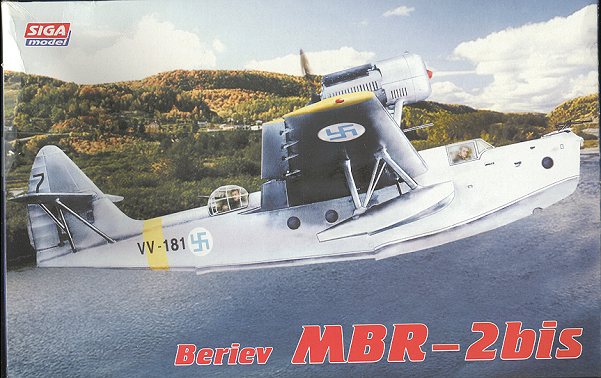
|
KIT: |
Siga 1/72 BreievMBR-2 bis |
|
KIT # |
72-D11 |
|
PRICE: |
$23.98 |
|
DECALS: |
Two Aircraft |
|
REVIEW & |
|
|
NOTES: |

|
HISTORY |
The most widely used short range Soviet flying boat was the Beriev MBR-2. First flying in 1931, this metal winged, wooden hulled flying boat had superb hydrodynamic qualities, could be operated with wheels or skis and had a pretty good load lifting capability. In first entered service in 1933 and was in production until 1942 by which time over 1,500 had been built. Initial power came from a license built BMW 12 cylinder engine of 680 hp which the Soviets designated the M-17. The later bis version was powered by an 850 hp M-34. The aircraft set several records for the type in the late 1930s and was used throughout the Great Patriotic War in a myriad of duties. Many survived the war and were used until the early 1950s.
|
THE KIT |

I've never built a Siga kit. However, those reviews I have read have been, shall we say, a bit less than positive. Not really that unusual as this is yet another Ukrainian kit. While these companies have made leaps and bounds in terms of progress in the model making art, they still have a bit to go to where they are truly considered mainstream. However, I understand that national sales are really quite high for all locally made models and that is good.
Not since Matchbox have I seen a kit molded in multiple colors. Yet this one is in three shades of grey. The parts have some flash and on large pieces (like the fuselage sides) there are a number of sink marks. This is often caused by not allowing the parts sufficient cooling before removing them from the mold. Further proof of this is shown in several of the smaller sprues which are warped. The large parts have some pretty hefty ejector pin marks on them, though they are easy to remove and are not on the outside. There are none on the smaller bits, which is a very pleasant surprise.
Clear parts are a bit cloudy, but not that bad as there really is very little to see on the interior. The canopy on one side is such that it can be displayed open. The cockpit itself is your basic seat, sticks and rudder pedals on a flat base. Interestingly, there is a dual control wheel setup, but only one seat! There is a floor in the back of the fuselage, but I think it is just so that when you look through the turret, you'll see something flat. There is also a floor for the open bow position. This must have been a rather cold aircraft to fly in the winter! Though there are main wheels, a tail skid, and probably struts for the amphibious version, no mention is made of them in the instructions. Other than two light bombs, there are no options.
 The instruction sheet is three
large assembly sections with all the smaller sub assemblies shown on the side.
Colors given are generic. The entire instruction sheet is written in English so
it is pretty obvious that this kit was intended for export. Markings are for
three aircraft; two Finnish and one North Korean. The Finnish aircraft can
either be painted in black and dark green over silver with yellow underwing
areas or overall silver. The North Korean boat is only shown in overall silver.
Not sure if this is meant to be natural metal or silver paint. The small decal
sheet is well printed and the decals are quite gloss.
The instruction sheet is three
large assembly sections with all the smaller sub assemblies shown on the side.
Colors given are generic. The entire instruction sheet is written in English so
it is pretty obvious that this kit was intended for export. Markings are for
three aircraft; two Finnish and one North Korean. The Finnish aircraft can
either be painted in black and dark green over silver with yellow underwing
areas or overall silver. The North Korean boat is only shown in overall silver.
Not sure if this is meant to be natural metal or silver paint. The small decal
sheet is well printed and the decals are quite gloss.
|
CONCLUSIONS |
You can add this kit to a list of 'planes I never thought I'd see in injected plastic'. Very little is actually known about their operations and seeing it in North Korean markings was a real surprise. It does not look that difficult to build and if your penchant is toward small flying boats, then this kit really needs to be in your collection!
|
REFERENCES |
War Planes of the Second World War: Vol 5, Flying Boats, William Green, 1962
A great photo reference for Soviet MBR-2s is Red Stars, by Geust, Keskinen, and Stenman. Only the hardcover version has MBR-2 photos; none are in any of the soft cover editions.
Review kit courtesy of my kit collection.
If you would like your product reviewed fairly and quickly by a site that has over 100,000 visits a month, please contact me or see other details in the Note to Contributors.